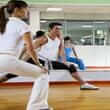Background
- The Alexander technique is an educational program that teaches movement patterns and postures, with an aim to improve coordination and balance, reduce tension, relieve pain, alleviate fatigue, improve various medical conditions, and promote well-being. Actors, dancers, and athletes use the Alexander technique with the goal of improving performance. This technique is available through wellness centers, health education programs, and from individual practitioners.
- The Alexander technique can be traced to F.M. Alexander, an Australian-English actor, who attributed his own intermittent voice loss to poor head and neck posture. Alexander believed that people could be trained to detect and eliminate harmful movement patterns and positions.
- Musculoskeletal approaches like the Alexander technique are advocated by many behavioral scientists and physiologists, although there are few scientific studies of this technique specifically.
References
- Austin JH, Ausubel P. Enhanced respiratory muscular function in normal adults after lessons in proprioceptive musculoskeletal education without exercises. Chest 1992;102(2):486-490.
View Abstract - Cacciatore TW, Horak FB, Henry SM. Improvement in automatic postural coordination following alexander technique lessons in a person with low back pain. Phys Ther 2005;85(6):565-578.
View Abstract - Dennis RJ. Musical performance and respiratory function in wind instrumentalists: effects of the Alexander technique of musculoskeletal education (abstract). Dissertation Abstracts International 1988;48(7):1689a.
- Dennis J. Alexander technique for chronic asthma. Cochrane Database Syst Rev 2000;(2):CD000995.
View Abstract - Dennis RJ. Functional reach improvement in normal older women after Alexander Technique instruction. J Gerontol A Biol Sci Med Sci 1999;54(1):M8-11.
View Abstract - Ernst E, Canter PH. The Alexander technique: a systematic review of controlled clinical trials. Forsch Komplementarmed Klass Naturheilkd 2003;10(6):325-329.
View Abstract - Knebelman S. The Alexander technique in diagnosis & treatment of craniomandibular disorders. Basal Facts 1982;5(1):19-22.
View Abstract - Little P, Lewith G, Webley F, et al. Randomised controlled trial of Alexander technique lessons, exercise, and massage (ATEAM) for chronic and recurrent back pain. BMJ 2008 Aug 19;337:a884.
View Abstract - Maitland S, Horne R, Burtin M. An exploration of the application of the Alexander technique for people with learning disabilities. Br J Learn Disabil 1996;24:70-76.
- Nuttall W. The Alexander principle: a consideration of its relevance to early childhood education in England today. Eur Early Child Ed Res J 1999;7(2):87-101.
- Schulte D, Walach HFM. Alexander technique in the treatment of stuttering-- a randomized single-case intervention study with ambulatory monitoring. Psychother Psychosom 2006;75(3):190-191.
View Abstract - Stallibrass C. An evaluation of the Alexander Technique for the management of disability in Parkinson's disease--a preliminary study. Clin Rehabil 1997;11(1):8-12.
View Abstract - Stallibrass C, Hampson M. The Alexander technique: its application in midwifery and the results of preliminary research into Parkinson's. Complement Ther Nurs.Midwifery 2001;7(1):13-18.
View Abstract - Swinburne C. From the top. Nurs Stand. 1-25-2006;20(20):20-22.
View Abstract - Valentine ER, Gorton TL, Hudson JA, et al. The effect of lessons in the Alexander technique on music performance in high and low stress situations. Psychol Music 1995;23:129-141.







